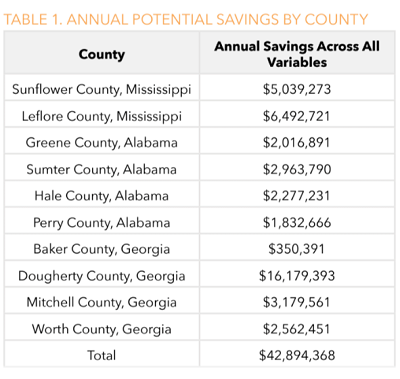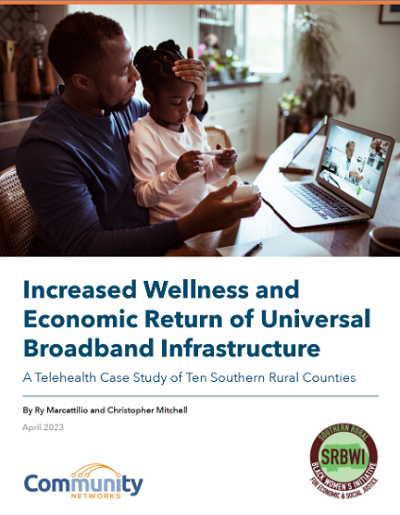
Fast, affordable Internet access for all.

In partnership with the Southern Rural Black Women’s Initiative (SRBWI), today ILSR is releasing a new report that examines the link between high-speed Internet infrastructure, access to healthcare, and the economic implications involved.
The report – “Increased Wellness and Economic Return of Universal Broadband Infrastructure: A Telehealth Case Study of Ten Southern Rural Counties” – has particular relevance for those living in rural broadband deserts as it details how universal, affordable, broadband infrastructure would return $43 million per year using telehealth across 10 counties in the Black Belt of Alabama, Georgia, and Mississippi.
At a virtual press briefing today, SRBWI leaders and organizers were joined by Dr. Sandra B. Reed of Emory Healthcare; as well as ILSR Senior Researcher and the report’s lead author, Ry Marcattilio, to explain how robust broadband infrastructure could pay for itself in short order and open up untold access to healthcare, educational opportunities, economic development, community engagement, and other benefits along the way.

“It’s easy to miss the connection, but hard to overlook what’s at stake as rural hospitals close and the cost of transportation to get to far-off healthcare facilities presents a real barrier. This is about access to healthcare and Black women being denied the opportunity to take advantage of telehealth. The broadband infrastructure that’s needed for that just isn’t there,” said Shirley Sherrod, SRBWI State Lead for Georgia and Director of the Southwest Georgia Project in Albany Georgia.
Broadband … to Access Longer, Healthier Lives
SRBWI, which serves 77 counties throughout the Alabama and Georgia Black Belt and across the Mississippi Delta, last year issued a widely-covered report on how Black women disproportionately die from cervical cancer due to a lack of access to healthcare and information.
This latest report not only builds on SRBWI’s previous advocacy around more equitable access to healthcare for Black women, its release happens to coincide with those state’s deciding where to invest their portion of the $42.5 billion for broadband infrastructure from the bipartisan infrastructure bill passed by Congress in November 2021.
“The pandemic has shown us all how critical broadband is and this lack of vital infrastructure is hitting Black women across the rural south the hardest – depriving far too many of the opportunity to advance economically or access critical services enabling them to enjoy longer, healthier lives,” added Oleta Garrett Fitzgerald, SRBWI State Lead for Mississippi and SRBWI Regional Administrator.
Model Return on Investment
Authored by ILSR senior researcher Ry Marcattilio and ILSR Community Broadband Networks Initiative Director Christopher Mitchell, they write in the executive summary:

“By the most reasonable conservative estimates, we show that preventable emergency department visits, preventable hospital admissions and readmissions, and lost economic productivity offer huge savings opportunities for these ten counties, totaling almost $43 million each year.”
They go on to write that “the goal of this report is to model the return on investment that would come from the construction of universal, robust broadband infrastructure to deliver affordable Internet access in these counties – based on the avoidable costs from chronic and acute health conditions that can be gained from telehealth interventions.”
Online Calculator
While the report has applications for the rest of the nation, the counties focused on in the study include: Sunflower County, Mississippi; Leflore County, Mississippi; Greene County, Alabama; Sumter County, Alabama; Hale County, Alabama; Perry County, Alabama; Baker County, Georgia; Dougherty County, Georgia; Mitchell County, Georgia; and Worth County, Georgia.
The savings modeled in this case study can be extended to anywhere in the country. To demonstrate that, ILSR has created an online calculator for users to calculate the same benefits based on county population, hospitalization rates, employment, and the distance to the nearest hospital.
“The benefits of telehealth are not often talked about in relation to broadband. Hopefully, this report will help move the needle,” the report’s lead author Ry Marcattilio said.
'Broadband will make all of our lives so much better'
Trudie Spears, a resident of Baker County, Georgia and a recent telehealth patient, also spoke during the press briefing. She shared her personal experience as a new telehealth patient and the potential it has to improve health outcomes and give patients like her access to vital medical information.
"Baker County has a population of less than 5,000. It's a widespread county, primarily farmland. The Internet is the way we can connect to the rest of world," she said, adding that in the area where she lives not only is broadband coverage inadequate, where service is available, it is not is affordable.
After recently participating in a telehealth pilot program that allowed her begin wellness check-ups online, Spears has come away, she said, "more informed than I would have than in a face-to-face appointment because doctors are so busy. Telehealth is beneficial for everyone, especially in areas like mine because some don't have transportation or they have mobility issues."
"Broadband will make all of our lives so much better because this is the future," she said.
